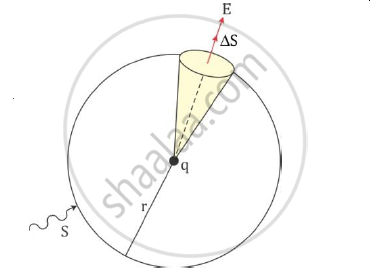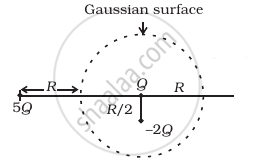Advertisements
Advertisements
प्रश्न
State and explain Gauss’s law.
उत्तर
Gauss’s law states that the flux of the electric field through any closed surface S is 1/∈ₒ times the total charge enclosed by S
Let the total flux through a sphere of radius r enclose a point charge q at its centre. Divide the sphere into a small area element as shown in the figure.

The flux through an area element ΔS is
`Deltaphi=E.DeltaS=q/(4piin_0r^2)hatr.DeltaS`
Here, we have used Coulomb’s law for the electric field due to a single charge q.
The unit vector `hatr`is along the radius vector from the centre to the area element. Because the normal to a sphere at every point is along the radius vector at that point, the area element ΔS and `hatr` have the same direction. Therefore
`Deltaphi=q/(4piin_0r^2)DeltaS`
Because the magnitude of the unit vector is 1, the total flux through the sphere is obtained by adding the flux through all the different area elements.
`phi=sum_(all DeltaS)q/(4piin_0r^2)DeltaS`
Because each area element of the sphere is at the same distance r from the charge,
`phi=q/(4piin_0r^2)sum_(all DeltaS)DeltaS=q/(4piin_0r^2)S`
Now, S the total area of the sphere equals 4πr². Thus,
`pi=q/(4piin_0r^2)xx4pir^2=q/in_0`
Hence, the above equation is a simple illustration of a general result of electrostatics called Gauss’s law
APPEARS IN
संबंधित प्रश्न
A charge ‘q’ is placed at the centre of a cube of side l. What is the electric flux passing through each face of the cube?
Answer the following question.
State Gauss's law for magnetism. Explain its significance.
Which of the following statements is not true about Gauss’s law?
If there were only one type of charge in the universe, then ______.
- `oint_s` E.dS ≠ 0 on any surface.
- `oint_s` E.dS = 0 if the charge is outside the surface.
- `oint_s` E.dS could not be defined.
- `oint_s` E.dS = `q/ε_0` if charges of magnitude q were inside the surface.
Consider a region inside which there are various types of charges but the total charge is zero. At points outside the region
- the electric field is necessarily zero.
- the electric field is due to the dipole moment of the charge distribution only.
- the dominant electric field is `∞ 1/r^3`, for large r, where r is the distance from a origin in this region.
- the work done to move a charged particle along a closed path, away from the region, will be zero.
Refer to the arrangement of charges in figure and a Gaussian surface of radius R with Q at the centre. Then

- total flux through the surface of the sphere is `(-Q)/ε_0`.
- field on the surface of the sphere is `(-Q)/(4 piε_0 R^2)`.
- flux through the surface of sphere due to 5Q is zero.
- field on the surface of sphere due to –2Q is same everywhere.
An arbitrary surface encloses a dipole. What is the electric flux through this surface?
A charge Q is placed at the centre of a cube. The electric flux through one of its faces is ______.
